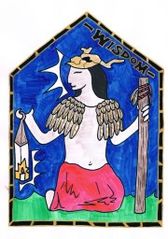Wisdom
The Path of Wisdom
Wisdom is, perhaps, the hardest of the Virtues to quantify, because by its very nature, everyone believes themselves possessed of it. Few have none at all; yet ordinary knowledge and common sense are not the Imperial Virtue of Wisdom. Wisdom is a lifelong journey – some argue several lifetimes long – and even those who come to an understanding of the Path at a young age must never dawdle on their way along it. Only the fool believes their journey is complete.
Like Pride, Wisdom often varies with context. Sage advice when dealing with a nest of trolls may prove ruinous against a Sovereign of Varushka, and the Winter magician who tries the same bargaining with Agramant as with Sorin is unlikely to leave the Wendigo’s presence alive.
Wisdom must also be applied, else it is useless. It is not enough that a Citizen know what the problem is, or even what the solution is, if they do not know how to put it into practice. Often that can involve simply spreading the Wisdom around – a Dawnish troubadour’s florid song and a Varushkan general’s brusque briefing may both pass on important information (albeit not at the same meeting). More personally, it can involve taking direct action to bring about the best outcome: the Freeborn Hakima who bangs two Dhomiros’ heads together when they are arguing over a triviality and the Varushkan Volhov who travels miles to set up a marriage between two young people who have never met yet are both simply solving problems with an outsider’s clarity, divorced from the concerns of those who can’t see the wood for the trees.
For this reason and another, many who follow the Virtue of Wisdom tend to be a little outside their society, keeping aloof from day-to-day concerns in order to keep their eyes on broader trends, rules and principles. The other reason is caution: sometimes it is safer to keep information or advice from a person at risk of jumping to the wrong conclusions, or acting foolishly on the right ones.
Folly and complacency – referred to in some traditional theology as the Greater and Lesser Enemies of Wisdom – must be fiercely guarded against, prevented at all costs. Of course, this is true in many of the Virtues; like Courage, Wisdom is often called a “structural Virtue” for its place in judiciously advising the application of all the others. The Emperor Nicovar is often held up as an example of how one Virtue must not be allowed to strangle out the others, even in a Dedicate: in his case, Vigilance strangling out Wisdom, Courage, and even Pride. Others cite Loyalty without Wisdom as the most dangerous of all, since a mighty and Virtuous person without the Wisdom to recognise that they serve a wicked master can do as much harm as a traitor among the ranks..
Guidance on the Path
Through study of the Paragons and Exemplars, the priests of The Way have gleaned insight into the heart of the Virtue and how best to pursue it. There are collections of parables, tales, sayings and teachings that distill this for Imperial Citizens to learn from. The following are a handful of teachings and sayings deemed to be essential to understanding the Path:
- The Virtuous apply what they have learned; wisdom knows all knowledge is incomplete.
- Let every word you speak carry meaning; do not use forty when four will do.
- Wisdom is not always knowing the answer; wisdom is finding the right question.
- Test what you learn; only fools accept hearsay as truth.
- Despise folly and chastise the fool that spreads it.
Paragons and Exemplars
Recognised Paragons and Exemplars of Wisdom include:
- The legendary Paragon Zoria learned the names of all the creatures of the wild; bird and beast, fish and fowl and using their names, commanded them to serve her.
- The Paragon Isenbrad of the Steinr was known for practicality, good judgement and wise counsel, and is said to have been the first runesmith
- The Paragon Atun of the Highborn steered the ships that bore the Highborn through unknown waters to their new homeland.
- The Exemplar Avigliana di Sarvos of League encouraged others to take note of the world they lived in and put the truth of it in writing.
- The Exemplar Kala codified a system of weights and measures that is still in use today.
Symbols, icons and trappings
The Path of Wisdom has many symbols across the Empire. Before the formation of the Synod, animal sigils were popular, in recognition of Zoria’s mastery of animals. However, the Synod has since discouraged this as The Way exalts the human spirit and beasts are lesser (though the practice exists still in parts of Varushka). As a consequence, more widely accepted symbols are scales as used by Kala to weigh and measure the world, and a lantern as used by Isenbrad to illuminate the cave in which he carved his secrets in runic form.
Many Priests and Pilgrims of the Path of Wisdom often carry sources of light, or the means to provide such. Many also carry the means to record such knowledge and wisdom that they encounter.
Further reading
- You can learn about the various spiritual roleplaying effects created by priests dedicated to Wisdom here.
- You can learn about the skills that priests can use to enlighten others to the virtue of Wisdom here.
